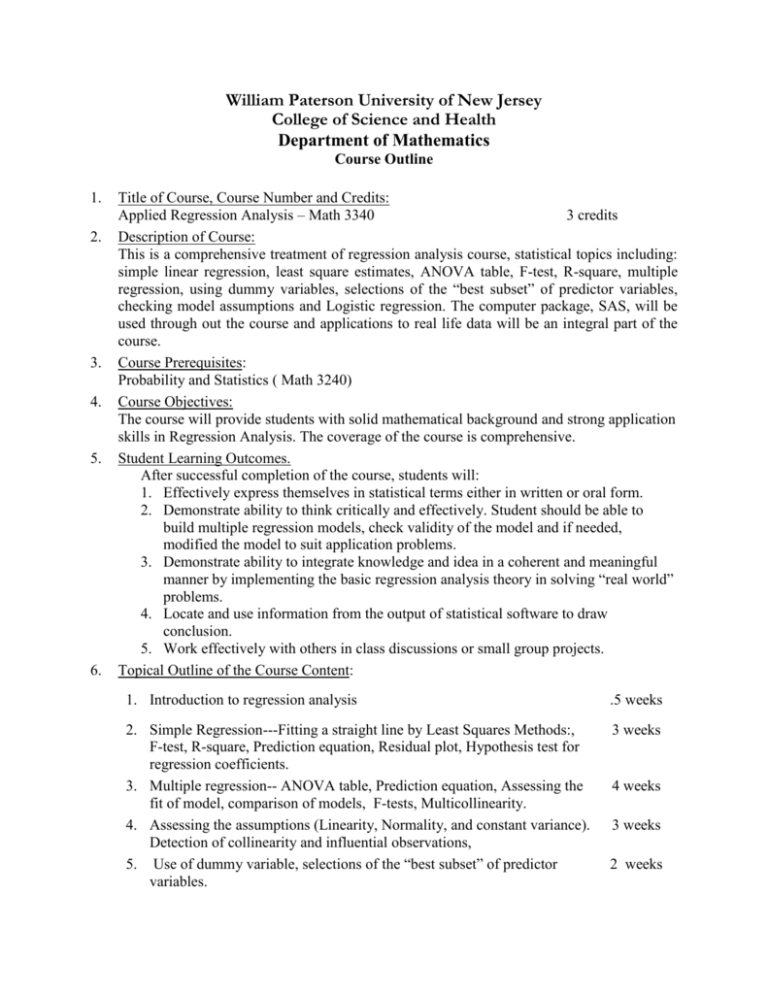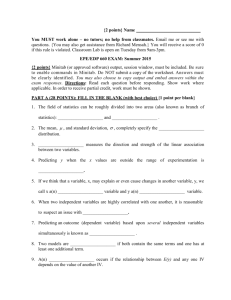MATH 3340 Applied Regression Analysis
advertisement

William Paterson University of New Jersey College of Science and Health Department of Mathematics Course Outline 1. 2. 3. 4. 5. 6. Title of Course, Course Number and Credits: Applied Regression Analysis – Math 3340 3 credits Description of Course: This is a comprehensive treatment of regression analysis course, statistical topics including: simple linear regression, least square estimates, ANOVA table, F-test, R-square, multiple regression, using dummy variables, selections of the “best subset” of predictor variables, checking model assumptions and Logistic regression. The computer package, SAS, will be used through out the course and applications to real life data will be an integral part of the course. Course Prerequisites: Probability and Statistics ( Math 3240) Course Objectives: The course will provide students with solid mathematical background and strong application skills in Regression Analysis. The coverage of the course is comprehensive. Student Learning Outcomes. After successful completion of the course, students will: 1. Effectively express themselves in statistical terms either in written or oral form. 2. Demonstrate ability to think critically and effectively. Student should be able to build multiple regression models, check validity of the model and if needed, modified the model to suit application problems. 3. Demonstrate ability to integrate knowledge and idea in a coherent and meaningful manner by implementing the basic regression analysis theory in solving “real world” problems. 4. Locate and use information from the output of statistical software to draw conclusion. 5. Work effectively with others in class discussions or small group projects. Topical Outline of the Course Content: 1. Introduction to regression analysis .5 weeks 2. Simple Regression---Fitting a straight line by Least Squares Methods:, F-test, R-square, Prediction equation, Residual plot, Hypothesis test for regression coefficients. 3. Multiple regression-- ANOVA table, Prediction equation, Assessing the fit of model, comparison of models, F-tests, Multicollinearity. 4. Assessing the assumptions (Linearity, Normality, and constant variance). Detection of collinearity and influential observations, 5. Use of dummy variable, selections of the “best subset” of predictor variables. 3 weeks 4 weeks 3 weeks 2 weeks Applied Regression Analysis – Math 3340 6. Logistic regression 7. 1 weeks Guidelines/Suggestions for Teaching Methods and Student Learning Activities: Lectures, classroom discussions and computer lab. 8. Guidelines/Suggestions for Methods of Student Assessment (Student Learning Outcomes) Through quizzes, tests, projects and the final examination 9. Suggested Reading, Texts and Objects of Study: Applied Regression Analysis, by T.E. Dielman, Duxbury Press. 10. Bibliography of Supportive Texts and Other Materials: Applied regression Analysis, by Draper, N. R. and Smith, H. Latest Edition, John Wiley & Sons, Inc. 11. Preparer’s Name and Date: Peter Chen, Spring 2006 12. Original Department Approval Date: Spring 2006 13. Reviser’s Name and Date: 14. Departmental Revision Approval Date: Page 2 of 2









